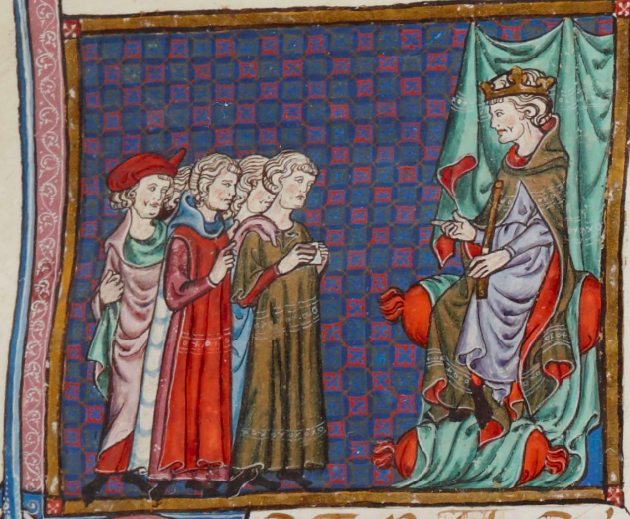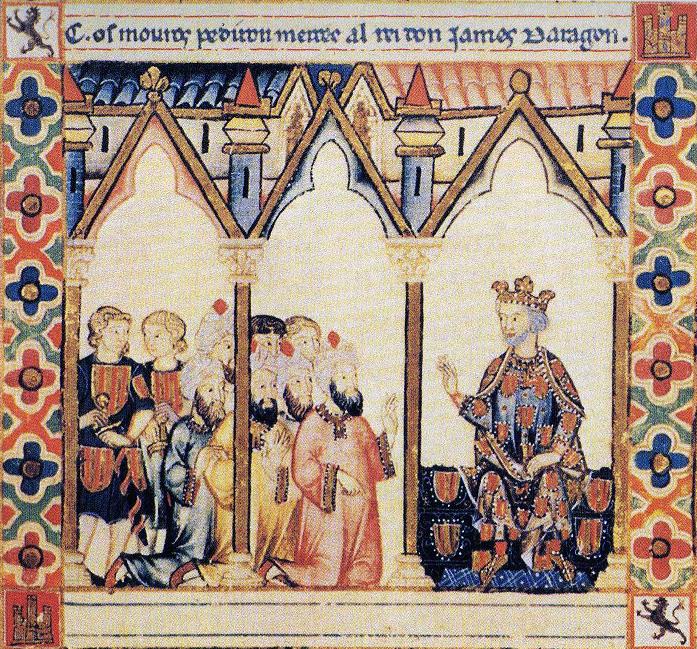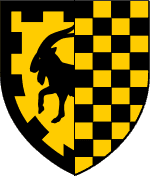|
Peironet
Peironet or Peyronet was a Catalan troubadour and jongleur (''juglar'' in contemporary records). "Peironet" is a diminutive of the Occitan name "Peire", meaning Peter. He might be the same person as Pere Salvatge. He was travelling with the entourage of the ''infante'' Peter, the heir to James I of Aragon, in October 1268 at Sant Celoni. He composed a ''tenso'' with the ''infante'' discussing the war with the County of Urgell that Peter had waged from September to December that year. Peironet and another jongleur who does not participate in the poetic exchange, Arnaut ''tritxador'', were apparently carrying a message to the ''infante'' about the status of his father the king. In the ''tenso'' Peironet talks about ''armes i amors'', war and love, the two favourite themes of the troubadours. The song, the incipit The incipit () of a text is the first few words of the text, employed as an identifying label. In a musical composition, an incipit is an initial sequence of notes, having ... [...More Info...] [...Related Items...] OR: [Wikipedia] [Google] [Baidu] |
Pere Salvatge
Pere Salvatge or Peire/Peyre Salvagge was a Catalan troubadour of the late thirteenth century ( fl. 1280–1287). He is most notable as a constant attendant at the court of Peter III and Alfonso III of Aragon. He may be the same person as the Peironet who composed poems with Peter III. Salvatge wrote the third piece in a five-piece cycle of ''sirventes'' written in Summer 1285. Early in the summer Bernart d'Auriac inaugurated the political debate by coming to the defence of the "three kings" Philip III of France, Philip of Navarre, and Charles of Valois, who claimed the Crown of Aragon. Under the direction of the French king they invaded Catalonia in the so-called "Aragonese Crusade". After Peter III of Aragon responded to Bernart, Pere responded to Peter in the short piece ''Senher, reys qu'enamoratz par''. Pere appears to have gotten his nickname from his occupation as a ''caballero salvaje'' or ''cavaller salvatge'' in the king's house. As such, he acted as messenger and ... [...More Info...] [...Related Items...] OR: [Wikipedia] [Google] [Baidu] |
Peter III Of Aragon
Peter III of Aragon ( November 1285) was King of Aragon, King of Valencia (as ), and Count of Barcelona (as ) from 1276 to his death. At the invitation of some rebels, he conquered the Kingdom of Sicily and became King of Sicily in 1282, pressing the claim of his wife, Constance II of Sicily, uniting the kingdom to the crown. Youth and succession Peter was the eldest son of James I of Aragon and his second wife Violant of Hungary. Among opportunistic betrothals of his youth, he was betrothed to Eudoxia Laskarina, the youngest daughter of Theodoros II Laskaris, in or before 1260 (''claim not substantiated''). This contract was dissolved, however, after Eudoxia's brother lost the imperial throne in 1261, and Eudoxia was instead married to the Count of Tenda. On 13 June 1262, Peter married Constance II of Sicily, daughter and heiress of Manfred of Sicily. During his youth and early adulthood, Peter gained a great deal of military experience in his father's wars of the ''Reconq ... [...More Info...] [...Related Items...] OR: [Wikipedia] [Google] [Baidu] |
Catalans
Catalans (Catalan language, Catalan, French language, French and Occitan language, Occitan: ''catalans''; es, catalanes, Italian language, Italian: ''catalani'', sc, cadelanos) are a Romance languages, Romance ethnic group native to Catalonia, who speak Catalan language, Catalan. The current official category of "Catalans" is that of the citizens of Catalonia, an autonomous communities of Spain, autonomous community in Spain and the inhabitants of the Roussillon historical region in southern France, today the Pyrénées Orientales department, also called Northern Catalonia and ''Pays Catalan'' in French. Some authors also extend the word "Catalans" to include all people from Catalan Countries, areas in which Catalan is spoken, namely those from Andorra, Valencian Community, Valencia, the Balearic islands, la Franja, eastern Aragon, Roussillon, and the city of Alghero in Sardinia. The Catalan government regularly surveys its population regarding its "sentiment of belonging". ... [...More Info...] [...Related Items...] OR: [Wikipedia] [Google] [Baidu] |
Troubadour
A troubadour (, ; oc, trobador ) was a composer and performer of Old Occitan lyric poetry during the High Middle Ages (1100–1350). Since the word ''troubadour'' is etymologically masculine, a female troubadour is usually called a ''trobairitz''. The troubadour school or tradition began in the late 11th century in Occitania, but it subsequently spread to the Italian and Iberian Peninsulas. Under the influence of the troubadours, related movements sprang up throughout Europe: the Minnesang in Germany, ''trovadorismo'' in Galicia and Portugal, and that of the trouvères in northern France. Dante Alighieri in his ''De vulgari eloquentia'' defined the troubadour lyric as ''fictio rethorica musicaque poita'': rhetorical, musical, and poetical fiction. After the "classical" period around the turn of the 13th century and a mid-century resurgence, the art of the troubadours declined in the 14th century and around the time of the Black Death (1348) it died out. The texts of troubadou ... [...More Info...] [...Related Items...] OR: [Wikipedia] [Google] [Baidu] |
Jongleur
A minstrel was an entertainer, initially in medieval Europe. It originally described any type of entertainer such as a musician, juggler, acrobat, singer or fool; later, from the sixteenth century, it came to mean a specialist entertainer who sang songs and played musical instruments. Description Minstrels performed songs which told stories of distant places or of existing or imaginary historical events. Although minstrels created their own tales, often they would memorize and embellish the works of others. Frequently they were retained by royalty and high society. As the courts became more sophisticated, minstrels were eventually replaced at court by the troubadours, and many became wandering minstrels, performing in the streets; a decline in their popularity began in the late 15th century. Minstrels fed into later traditions of travelling entertainers, which continued to be moderately strong into the early 20th century, and which has some continuity in the form of today's bu ... [...More Info...] [...Related Items...] OR: [Wikipedia] [Google] [Baidu] |
Occitan Language
Occitan (; oc, occitan, link=no ), also known as ''lenga d'òc'' (; french: langue d'oc) by its native speakers, and sometimes also referred to as ''Provençal'', is a Romance languages, Romance language spoken in Southern France, Monaco, Italy's Occitan Valleys, as well as Spain's Val d'Aran; collectively, these regions are sometimes referred to as Occitania, Occitània. It is also spoken in Calabria (Southern Italy) in a linguistic enclave of Cosenza area (mostly Guardia Piemontese). Some include Catalan language, Catalan in Occitan, as the Linguistic distance, distance between this language and some Occitan dialects (such as the Gascon language) is similar to the distance between different Occitan dialects. Catalan was considered a dialect of Occitan until the end of the 19th century and still today remains its closest relative. Occitan is an official language of Catalonia, where a subdialect of Gascon known as Aranese dialect, Aranese is spoken in the Val d'Aran. Since Sept ... [...More Info...] [...Related Items...] OR: [Wikipedia] [Google] [Baidu] |
Peter (given Name)
Peter is a common masculine given name. It is derived directly from Greek , ''Petros'' (an invented, masculine form of Greek ''petra,'' the word for "rock" or "stone"), which itself was a translation of Aramaic ''Kefa'' ("stone, rock"), the new name Jesus gave to apostle Simon Bar-Jona. An Old English variant is Piers. In other languagess The following names can be interpreted as ''Peter'' in English. * Afrikaans: Pieter, Petrus * Albanian: Pjetër, Prel * Amharic: ጴጥሮስ ("Ṗeṭros") * Arabic: بطرس ('' Boutros''), بيار ("Pierre," mainly in Lebanon), بيتر ("Peter," exact transcription) * Aragonese: Pietro, Pero, Piero, Pier * Azerbaijani: Pyotr * Armenian: Պետրոս (''Bedros'' in Western dialect, ''Petros'' in Eastern dialect) * Asturian: Pedru * Basque: Peru, Pello (diminutive), Pedro, Piarres, Petri (Biblical), Kepa (neologism) * Belarusian: Пётр (''Piotr''), Пятро (''Piatro''), Пятрусь (''Piatrus'') * Bengali: পাথর (''Pathor' ... [...More Info...] [...Related Items...] OR: [Wikipedia] [Google] [Baidu] |
Infante
''Infante'' (, ; f. ''infanta''), also anglicised as Infant or translated as Prince, is the title and rank given in the Iberian kingdoms of Spain (including the predecessor kingdoms of Aragon, Castile, Navarre, and León) and Portugal to the sons and daughters (''infantas'') of the king, regardless of age, sometimes with the exception of the heir apparent or heir presumptive to the throne who usually bears a unique princely or ducal title.de Badts de Cugnac, Chantal. Coutant de Saisseval, Guy. ''Le Petit Gotha''. Nouvelle Imprimerie Laballery, Paris 2002, p. 303, 364-369, 398, 406, 740-742, 756-758 (French) A woman married to a male ''infante'' was accorded the title of ''infanta'' if the marriage was dynastically approved (e.g., Princess Alicia of Bourbon-Parma), although since 1987 this is no longer automatically the case in Spain (e.g., Princess Anne d'Orléans). Husbands of born ''infantas'' did not obtain the title of ''infante'' through marriage (unlike most hered ... [...More Info...] [...Related Items...] OR: [Wikipedia] [Google] [Baidu] |
James I Of Aragon
James I the Conqueror ( es, Jaime el Conquistador, ca, Jaume el Conqueridor; 2 February 1208 – 27 July 1276) was King of Aragon and Lord of Montpellier from 1213 to 1276; King of Majorca from 1231 to 1276; and Valencia from 1238 to 1276 and Count of Barcelona. His long reign—the longest of any Iberian monarch—saw the expansion of the Crown of Aragon in three directions: Languedoc to the north, the Balearic Islands to the southeast, and Valencia to the south. By a treaty with Louis IX of France, he achieved the renunciation of any possible claim of French suzerainty over the County of Barcelona and the other Catalan counties, while he renounced northward expansion and taking back the once Catalan territories in Occitania and vassal counties loyal to the County of Barcelona, lands that were lost by his father Peter II of Aragon in the Battle of Muret during the Albigensian Crusade and annexed by the Kingdom of France, and then decided to turn south. His great part i ... [...More Info...] [...Related Items...] OR: [Wikipedia] [Google] [Baidu] |
Sant Celoni
Sant Celoni () is a municipality in the ''comarca'' of the Vallès Oriental in Catalonia, Spain. It is situated in the valley of the Tordera river between the ranges of Montseny and Montnegre. The main part of the town is on the left bank of the river. The former municipalities of Montnegre and Olzinelles now form part of the municipality of sant Celoni, which has the largest area in the ''comarca''. The municipality is served by the AP-7 Motorway and the C-251 road, as well as by a station on the RENFE railway line between Barcelona and Girona. Geography The municipality of Sant Celoni comprises the town center, the most populated (17,076 inhabitants, 2012), plus come other group of scattered nuclei. The urban area of Pertegàs (260 inhabitants) is next to the town center, from which it is separated by the entrance road to Sant Celoni, connecting with the C-35 on the east side (Porta de Llevant). It is currently considered another neighborhood in the city center. Although i ... [...More Info...] [...Related Items...] OR: [Wikipedia] [Google] [Baidu] |
Tenso
A ''tenso'' (; french: tençon) is a style of troubadour song. It takes the form of a debate in which each voice defends a position; common topics relate to love or ethics. Usually, the tenso is written by two different poets, but several examples exist in which one of the parties is imaginary, including God (Peire de Vic), the poet's horse (Gui de Cavalhon) or his cloak (Bertran Carbonel). Closely related, and sometimes overlapping, genres include: * the ''partimen'', in which more than two voices discuss a subject * the ''cobla esparsa'' or ''cobla exchange'', a tenso of two stanzas only * the ''contenson'', where the matter is eventually judged by a third party. Notable examples *Marcabru and Uc Catola''Amics Marchabrun, car digam'' possibly the earliest known example. *Cercamon and Guilhalmi''Car vei finir a tot dia'' another candidate for the earliest known example. *Raimbaut d'Aurenga and Giraut de Bornelh''Ara·m platz, Giraut de Borneill'' where major exponents of the two ... [...More Info...] [...Related Items...] OR: [Wikipedia] [Google] [Baidu] |
County Of Urgell
The County of Urgell ( ca, Comtat d'Urgell, ; la, Comitatus Urgellensis) is one of the historical Catalan counties, bordering on the counties of Pallars and Cerdanya. History The county of Urgell was carved by the Franks out of a former section of the Mark of Toulouse when the Alt Urgell area became part of the Carolingian Empire between 785 and 790. The original territory was made up of the Alt Urgell, also known as Urgellet from the end of the 12th century onwards, with the see at La Seu d'Urgell. From 839 onwards it would include 129 villages, the valleys of the Valira river, namely Andorra and Sant Joan Fumat, the Segre riverine area as well as the valleys located between El Pont de Bar and Oliana. Its maximal extension territory was between the Pyrenees and the taifa of Lleida, that is, the current comarques of Alt Urgell or Urgellet, Noguera, Solsonès, Pla d'Urgell, Baix Urgell and the still independent country of Andorra. The historical capital was first la Seu d' ... [...More Info...] [...Related Items...] OR: [Wikipedia] [Google] [Baidu] |

.jpg)




